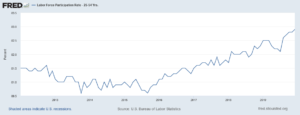September 03, 2022
I was on the road yesterday (literally). This meant I had to listen on the radio to many people who should know better say silly things about the big August jump in labor force participation rates (LFPR), and especially LFPR for prime-age workers (ages 25 to 54). In case you missed it, the overall LFPR rose by 0.3 percentage points, while the LFPR for prime-age workers rose by 0.4 percentage points.
To be clear, this is definitely good to see. Many of us were struck by the fact that LFPR for prime-age workers fell through the spring and into the summer even as the establishment survey showed that the economy was creating over 400,000 jobs a month. This didn’t seem consistent. There was some fall in the unemployment rate, but employment in the household survey actually fell by 168,000 between March and July. This was a period in which the establishment survey showed the economy creating almost 1.6 million jobs.
While this was bothersome. Folks who follow the data closely know that the household survey often does weird things. On a month-to-month basis, its movements are largely noise, and even over a period of several months it can often follow a path that is inconsistent with what we know about the economy.
Here’s the picture on changes in the seasonally adjusted prime-age LFPR from 2012 and 2019. (I’m using this period because it is one of relatively stable growth, without the big falloffs from the Great Recession or the Pandemic.)

Does anyone know of anything really bad that happened in June and July of 2015 that caused the LFPR for prime-age workers to drop by 0.6 percentage points and then another 0.1 percentage point? The economy grew at a 2.3 percent rate in the second quarter of that year and 1.3 percent in the third quarter. The establishment survey showed a gain of 174,000 jobs in June and 302,000 jobs in July.
Thankfully, whatever bad thing caused this plunge in LFPRs, it was reversed in the fall and winter. By February 2016, the prime-age LFPR was back to its May level of 81.2 percent.
This is not the only time we got bad news from the household survey that was later reversed. From March 2019 to July 2019, the prime-age LFPR fell by 0.9 percentage points. The economy grew at a 3.2 percent rate in the second quarter and 2.8 percent rate in third quarter. The establishment survey showed a gain of almost 600,000 jobs for this four-month period.
Fortunately, this bad news was quickly reversed and, by September, the prime-age LFPR was at 82.8 percent. This is 0.2 percentage points above its March level.
So, do we think that prime-age workers suddenly lost interest in working in the summer of 2015 and again in the spring-summer of 2019? And, then they changed their minds and decided to go back into the workforce in the next few months?
If there was a major change in policy on something like childcare or schools, perhaps these fluctuations would make sense. But if such changes happened, I must have missed them.
The long and short is that the movements in the household survey are erratic. This is true for a single month and can also be true over a several month period, as happened in the spring and summer of 2019.
Like everyone else, I use the data we have. When we see a change for the positive, as we did in August, that is good news. But, we also have to recognize that it may very well be noise.
For my part, I don’t believe that the fall in prime-age LFPR reported from March to July was real, so I don’t think there was actually a big jump in August. This is a case where the household survey is now looking more like the establishment survey and other economic data. (A third independent data source is payroll tax collections, which also looks like the establishment survey.)
I’m always happy to see when our data sources seem to line up as they should, but I’m not going to break out the champagne over the correction of a statistical anomaly.







Comments